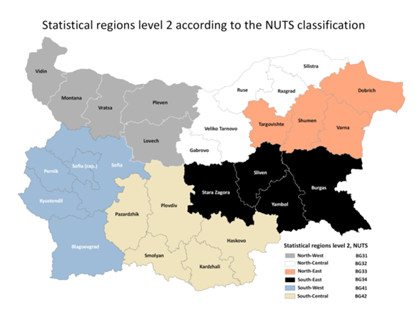| The survey covers all agricultural holdings, meeting at least one of the following criteria: Cultivation of at least: a) 0.5 ha (5 dca) of agricultural area used (A_3_1); b) 0.3 ha (3 dca) of arable land (B_1_1+B_1_2+…+B_1_11+B_1_12); c) 0.5 ha (5 dca) of natural meadows (B_3); d) 0.1 ha (1 dca) of orchard (pure culture) (part of B_4_1); e) 0.1 ha (1 dca) of vineyard; (B_4_4); f) 0.1 ha (1 dca net) of specialised crops (vegetables (B_1_7), hops (B_1_6_2), tobacco (B_1_6_1), spices, medical and essential oil crops (B_1_6_12), flowers, ornamental plants (B_1_8), berries (part of B_4_1), mushrooms (B_6_1), nurseries (B_4_5) etc.); g) 0.05 ha (0.5 dca) of greenhouses (B_1_7_2+B_1_8_2) Keeping of at least: a) 1 cow (C_2_5+C_2_6); b) 1 buffalo-cow ; c) 2 cattle (C_2); d) 2 buffaloes; e) 1 female for reproduction (equidae); f) 2 working animals (equidae); g) 5 pigs (C_4); h) 1 breeding-sow (C_4_2); i) 5 breeding-ewes (C_3_1_1); j) 2 breeding she-goats (C_3_2_1); k) 50 laying hens (C_5_2); l) 100 chicken for fattening (C_5_1); m) 10 honey-bee colonies (C_7); n) 10 rabbits (breeding females) (C_6); o) 1 reproductive male animal used for natural mating - bull, stud, boar; p) special animal and fowl species – 1 000 birds (C_5), 1 000 quails, 30 other birds (turkeys, geese, ducks etc.), ostriches (C_5_3) angora goats, angora rabbits, minks, nutrias, silkworms etc. Animal production: 10,000 eggs; 200 rabbits; 100 chickens for fattening; 10 lambs and / or goats; 5 pigs; 2 calves. Production of mushrooms - 500 kg mushrooms. The farm threshold applied is lower than the one required by Eurostat. All geographical areas are covered. The map presented in the Figure shows the grouping of statistical regions – level 2 according to the Nomenclature of Territorial Units for Statistics (NUTS) of the European Union under Regulation (EC) No 176/2008. The districts on NUTS 3 level according to the Regional Development Act are distributed as follows: Severozapaden (North-West Region) - Vidin, Vratsa, Montana, Lovech and Pleven; Severen tsentralen (North-Central Region) - Veliko Tarnovo, Gabrovo, Rousse, Razgrad and Silistra; Severoiztochen (North-East Region) - Varna, Dobrich, Targovishte and Shumen; Yugoiztochen (South-East Region) - Bourgas, Sliven, Yambol and Stara Zagora; Yugozapaden (South-West Region) - Blagoevgrad, Kyustendil, Pernik, Sofia (capital) and Sofia; Yuzhen tsentralen (South-Central Region) - Kardzhali, Pazardzhik, Plovdiv, Smolyan and Haskovo.  |



